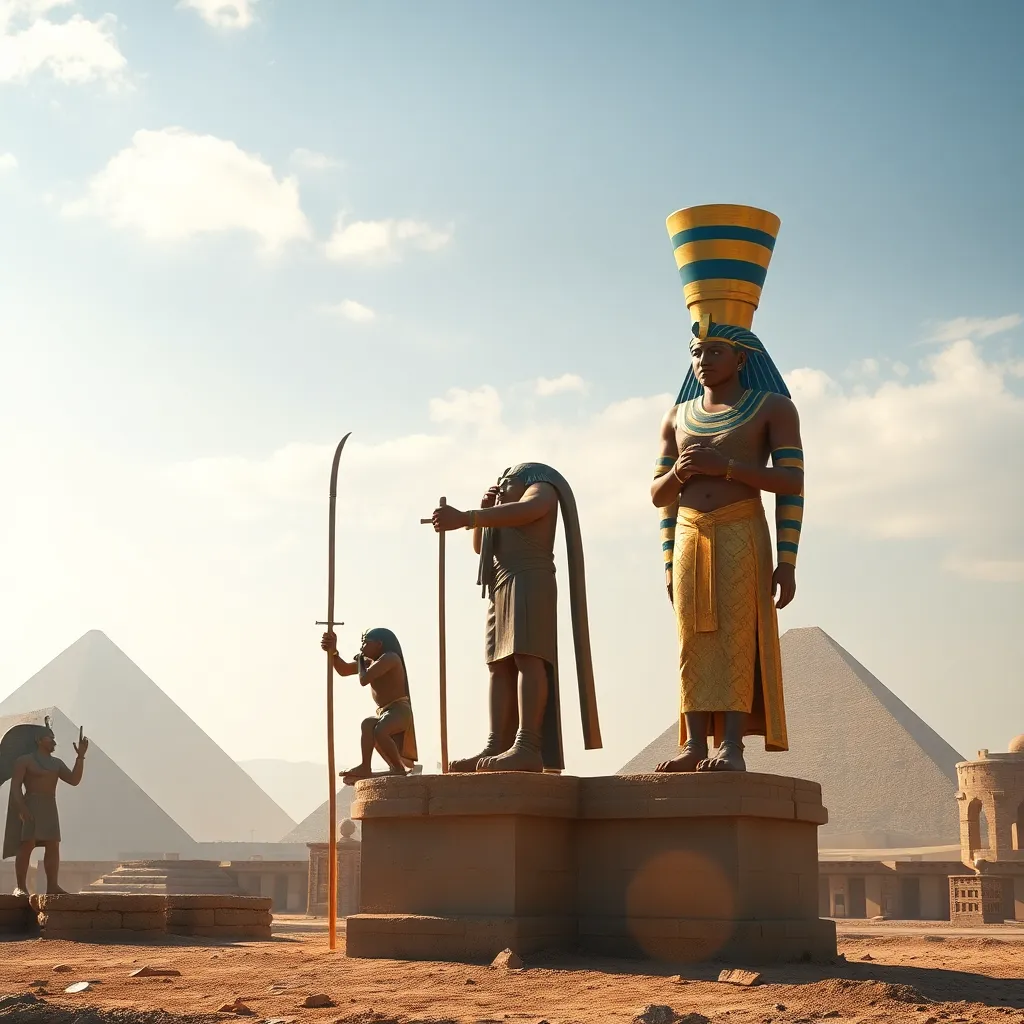The Gods, the Pharaohs, and the People: A Look at Ancient Egyptian Culture
I. Introduction
Ancient Egyptian civilization, one of the world’s oldest and most fascinating cultures, flourished along the Nile River for over three millennia. This remarkable society is renowned for its monumental architecture, intricate art, and profound religious beliefs. Understanding the intricate interrelationship between the gods, the pharaohs, and the people is essential to comprehending the essence of ancient Egypt.
II. The Pantheon of Egyptian Gods
A. Major deities and their roles in daily life
The ancient Egyptians worshipped a vast pantheon of gods and goddesses, each governing various aspects of the natural world and human experience. Here are some of the major deities:
- Ra: The sun god, considered the creator of all life.
- Osiris: The god of the afterlife and resurrection.
- Isis: The goddess of magic and motherhood.
- Horus: The god of the sky, often depicted as a falcon.
- Anubis: The god of mummification and the afterlife.
B. Myths and legends surrounding the gods
Myths played a central role in ancient Egyptian religion, explaining the origins of the world and the gods’ interactions with humanity. The myth of Osiris, for example, details his murder by his brother Set, his resurrection by Isis, and the establishment of the afterlife. Such stories reinforced moral values and cultural norms.
C. The significance of rituals and worship practices
Rituals were integral to ancient Egyptian worship, ensuring favor from the gods. Daily offerings, festivals, and temple ceremonies were common practices. These rituals were believed to maintain cosmic order and secure divine protection for the pharaoh and his people.
III. The Pharaohs: Divine Rulers of Egypt
A. The concept of divine kingship
Pharaohs were seen not merely as political leaders but as divine intermediaries between the gods and the people. They were considered living gods, responsible for maintaining ma’at, the balance of order and justice in the universe.
B. Notable pharaohs and their contributions to culture and architecture
Several pharaohs left indelible marks on Egyptian culture and architecture:
- Kings Narmer: Credited with unifying Upper and Lower Egypt.
- Khufu: Commissioned the Great Pyramid at Giza, a testament to engineering prowess.
- Hatshepsut: One of the few female pharaohs, known for her prosperous reign and magnificent temple.
- Ramses II: Known as Ramses the Great, he led military expeditions and constructed numerous temples.
C. The relationship between pharaohs and the gods
Pharaohs often sought validation from the gods through monumental building projects, such as temples dedicated to deities. They would undertake rituals to appease the gods and ensure the prosperity of their reign.
IV. Daily Life in Ancient Egypt
A. Social structure and class divisions
Ancient Egyptian society was hierarchical, with a distinct social structure. The classes included:
- Pharaoh: The supreme ruler.
- Nobility: High priests and officials.
- Artisans and craftsmen: Skilled laborers who created art and goods.
- Farmers and laborers: The backbone of the economy, working the land and building projects.
B. Roles of men, women, and children in society
Men typically held positions of power and worked as laborers, while women enjoyed certain rights, including property ownership. Children were valued and educated, often learning trades from their parents.
C. The impact of religion on daily activities and customs
Religion profoundly influenced daily life, dictating everything from agricultural practices to family ceremonies. Festivals celebrating the gods were communal affairs, fostering social cohesion.
V. Art and Architecture: Expressions of Culture
A. The significance of tombs and pyramids
Tombs and pyramids served as gateways to the afterlife, reflecting the Egyptians’ beliefs about death. The Great Pyramids of Giza, monumental structures, symbolized the pharaoh’s divine status and ensured his immortality.
B. Artistic styles and their meanings
Egyptian art was characterized by its adherence to strict conventions. Art was not merely decorative; it conveyed religious and cultural messages. Hieroglyphics, for example, were both an art form and a means of communication.
C. How art reflects the beliefs and values of ancient Egyptians
Artworks often depicted gods, pharaohs, and everyday life, emphasizing the importance of the afterlife, the divine, and the natural world. This artistic expression was a reflection of their values and beliefs.
VI. The Afterlife: Beliefs and Practices
A. Concepts of death and the afterlife in Egyptian culture
The Egyptians believed in an eternal afterlife, where one would be judged by Osiris. A positive judgment allowed the soul to enter the Field of Reeds, a paradise-like existence.
B. Burial practices and the importance of mummification
Mummification was vital to preserving the body for the afterlife. Elaborate burial practices included the construction of tombs filled with goods for use in the next life.
C. The role of the Book of the Dead in guiding souls
The Book of the Dead was a collection of spells and prayers designed to assist the deceased in navigating the afterlife, ensuring safe passage and favorable judgment.
VII. Innovations and Contributions to Civilization
A. Advancements in writing, mathematics, and science
Ancient Egyptians made significant contributions in various fields:
- Hieroglyphics: A sophisticated writing system that recorded history and culture.
- Mathematics: Developed for architectural and agricultural purposes.
- Medicine: Advanced medical practices and surgical techniques.
B. Influence of ancient Egyptian culture on future civilizations
The legacy of ancient Egypt influenced Greek and Roman cultures and continues to impact art, religion, and architecture today.
C. Preservation of knowledge through hieroglyphics and monuments
The Egyptians’ commitment to recording their knowledge in hieroglyphics and monumental architecture ensured that their culture was preserved for future generations.
VIII. Conclusion
The interplay between the gods, the pharaohs, and the people of ancient Egypt created a rich tapestry of culture that has fascinated historians and enthusiasts alike. The lasting legacy of this civilization endures in modern society, influencing art, religion, and architecture. We invite you to further explore the depths of this intriguing historical topic and uncover the mysteries of ancient Egypt.




